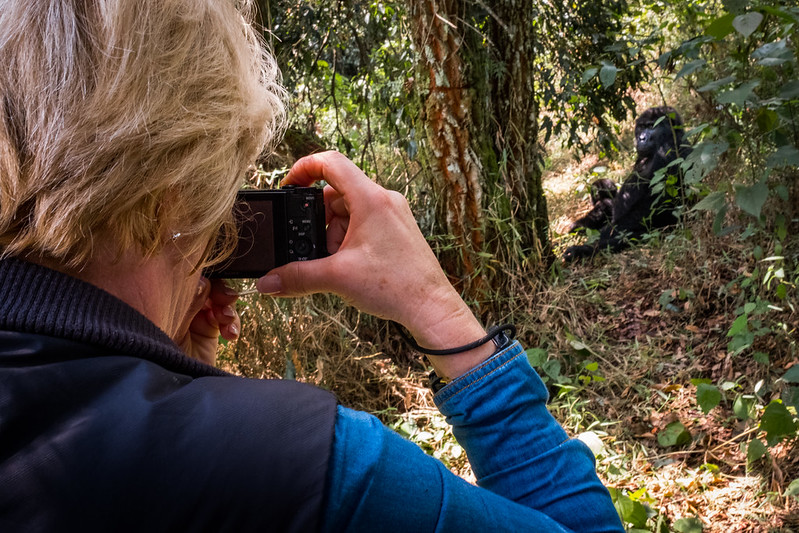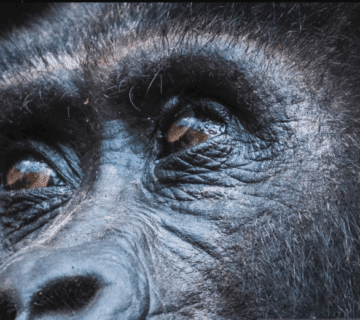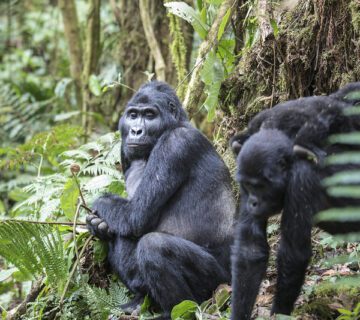Few experiences can match the drama and poignancy of encountering wild mountain gorillas in their natural habitats deep within East Africa’s forests. These majestic creatures, whose very survival is threatened, can be found in the mountainous regions of Rwanda, Uganda, and the Democratic Republic of the Congo. With only around 1,200 mountain gorillas remaining in the wild, these apes are among the world’s most endangered species, making every opportunity to see them a precious and rare experience.
Gorilla Habituation in Africa: A Unique Opportunity
Uganda stands out as a prime location for gorilla habituation experiences, largely because it is home to nearly half of the world’s remaining mountain gorilla population. Gorilla habituation allows visitors to spend an extended period—up to four hours—with a family of semi-habituated gorillas, offering an in-depth and unforgettable wildlife experience. This unique opportunity takes place in the heart of Uganda’s Bwindi Impenetrable Forest National Park, particularly in the southern part of the forest known as the Rushaga region.
Gorilla Habituation in Bwindi Rushaga Region
The Rushaga region in Bwindi Impenetrable Forest is the epicenter of gorilla habituation experiences in Africa. Here, visitors can join park rangers in tracking and observing these gentle giants as they go about their daily lives. The Gorilla Habituation Experience is unlike regular gorilla trekking. It involves more time spent with the gorillas and plays a crucial role in the gradual process of habituating these wild apes to human presence. This process ensures that the gorillas do not feel threatened or stressed by humans, making future interactions safer for both the animals and the visitors.
Starting your day early, you will follow fresh trails left by the gorillas the previous night, guided by skilled rangers who are intimately familiar with the terrain and the gorilla families that inhabit it. The experience not only allows you to observe the gorillas at close range but also provides insight into the ongoing conservation efforts aimed at protecting these incredible animals.
Why Choose Gorilla Habituation Over Regular Gorilla Trekking?
While both gorilla habituation and regular trekking offer thrilling opportunities to see mountain gorillas, the habituation experience is far more immersive. During a typical gorilla trek, visitors spend about an hour with a fully habituated gorilla family. In contrast, the Gorilla Habituation Experience gives you up to four hours to observe, photograph, and understand the gorillas’ behavior. This extended interaction offers a deeper connection with these animals and a better understanding of their daily lives.
Additionally, by participating in the habituation experience, you play an active role in the conservation efforts. Your presence helps the gorillas become more accustomed to humans, which is vital for their protection and the sustainability of eco-tourism in the region.
When Is the Best Time for Gorilla Habituation Experiences in Africa?
Gorilla habituation experiences in Africa, particularly in Uganda, are available year-round. The climate in Bwindi Impenetrable Forest is relatively stable, with temperatures ranging between 20 and 25 degrees Celsius throughout the year. However, the two dry seasons—June to August and December to February—are considered the best times to visit. During these months, the trails are less muddy, making the hike more manageable, and the chances of clear weather are higher.
That said, gorilla habituation can still be a rewarding experience during the wet seasons, which occur from March to May and October to November. While the rains can make the trails more challenging, they also bring certain advantages. The rain clears the air of dust, which can result in sharper photographs, and the combination of mist and rain creates a hauntingly beautiful atmosphere in the forest, enhancing the overall experience.
What to Pack for Gorilla Habituation Experiences in Africa
Preparing for a gorilla habituation experience requires careful planning and packing, as the trek through the dense and often rugged forest can be physically demanding. Here’s what you should bring to ensure a safe and comfortable experience:
Essential Clothing and Footwear
- Waterproof Hiking Boots: Choose boots with strong ankle support and a good grip to navigate the slippery and uneven terrain. To avoid blisters, wear high-quality walking socks and break in your boots before the trip.
- Lightweight, Breathable, Waterproof Clothing: A waterproof jacket and pants are essential, as Bwindi’s weather can change rapidly. Long-sleeved shirts and trousers will protect you from insect bites and help keep you warm during the cooler parts of the day.
- Hat and Sunglasses: These will protect you from the sun, especially during the drier seasons.
Additional Gear and Essentials
- Lightweight Backpack: Pack a small backpack to carry your lunch, a reusable water bottle, snacks, and essentials like sunscreen, insect repellent, after-sun lotion, bite relief cream, and lip balm.
- Binoculars: Binoculars are handy for spotting other wildlife, such as birds and monkeys, from a distance.
- Camera Gear: Bring a camera with extra batteries and a waterproof case to capture the incredible moments you’ll experience. The forest’s lighting can be tricky, so consider bringing a camera with a good low-light capability.
Final Thoughts on Gorilla Habituation Experiences in Africa
Gorilla habituation experiences in Africa, particularly in Uganda’s Bwindi Impenetrable Forest, offer a once-in-a-lifetime opportunity to connect with one of the world’s most endangered species. These experiences not only allow you to observe mountain gorillas in their natural environment but also play a crucial role in their conservation. By participating in a habituation experience, you contribute directly to the efforts to protect these magnificent creatures, ensuring that future generations will also have the chance to witness them in the wild.
Whether you’re a seasoned safari-goer or a first-time visitor to Africa, the Gorilla Habituation Experience in Bwindi’s Rushaga region is an adventure that will leave you with memories to cherish forever. With careful preparation and the right gear, you can fully immerse yourself in this remarkable wildlife experience, knowing that you’re part of a larger effort to preserve these incredible animals.



